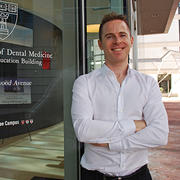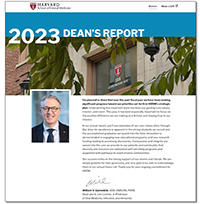
Dr. John Ahern joined HSDM as a Fulbright Scholar from Dublin, Ireland. Dr. Ahern received both his dental (2010) and medical (2015) degrees from Trinity College Dublin, and his masters in public health from the London School of Hygiene and Tropical Medicine (2013). He has worked as a dentist and physician and completed an internship at the World Health Organization’s (WHO) Department of Oral Health in Geneva, Switzerland. As a well-rounded healthcare professional, Dr. Ahern is passionate about the promotion of oral health through inter-professional collaboration and communication with other health professionals. We asked him about what led him to HSDM, his role as a Fulbright Scholar, and his goals for the future.
Can you tell us why you decided to pursue an MD/DMD, and why you have chosen to focus your research on public health & primary care?
When I was working in the Dublin Dental University Hospital, I was introduced to an impressive group of dual-qualified clinicians. As I was based primarily in the emergency department, I worked very closely with them, and it was a fantastic learning experience for me. Their level of knowledge, array of skills, and capacity to provide leadership to both oral and general health professionals, really inspired me to pursue dual-qualification.
In the years thereafter, I had somewhat of a dual-identity as a health professional. I continued to work part-time as a dentist in both hospital and community settings, while also training as a medical doctor. By working in both professions concomitantly, I was afforded a relatively unique position, which allowed me to identify a massive opportunity for the integration of oral health competencies within the skill set of other health professionals, especially primary care clinicians.
Why did you want to come to the Harvard School of Dental Medicine (HSDM)?
Well, all you have to do is look at HSDM’s mission statement to see why it is such a privilege for me to be here as a Fulbright Scholar. My initial contact with HSDM came in 2014, when I was on an elective in Brigham & Women’s Hospital. A few different U.S. and Irish sources had introduced me to Jane Barrow through email. We graciously conceded that the universe must be telling us something, and arranged to meet over coffee. Jane was full of ideas as to how we could work together to support each other’s mutual goals, and I was confident that I would fit in very well with the research activities here at HSDM.
I was also introduced to Dean Donoff, who was a powerful source of encouragement to pursue this goal, and being a dual-qualified clinician himself, he proved to be a real source of inspiration for me to come to HSDM. Now that I am here, I see this as a new chapter for me, and I hope to build lasting relationships at HSDM, both personal and professional, and create opportunities to build on these relationships long into the future.
How did you decide to apply for a Fulbright scholarship, and what does it mean to be a Fulbright scholar at HSDM?
When I returned to Ireland after that visit to Boston, I was updating one of my professors at Trinity College about my recent activities at the WHO, and telling him my goals for the future, which involved working with HSDM. He sat back in his chair, put his arms behind his head, and just when I thought he was going to tell me to get real and stop wasting my time, he leaned forward and said, “John, this is a fantastic idea, and it screams Fulbright.”
The Fulbright program is a very well-known scholarship internationally, and carries a lot of prestige, which was very helpful to me when promoting the idea of oral health integration among primary care clinicians. At first, this idea was getting mixed messages from both medical and dental audiences. I was even told by one medical doctor at a conference in England that the idea I was promoting was “very controversial”.
So winning the support of the Fulbright program was a hugely significant milestone for me, as it provided a platform to promote this idea on a larger scale and to a broader audience. It also encouraged people to listen more attentively to the principles behind the research, and it certainly fostered a greater interest from important stakeholders.
Read the full article in the fall issue of the Harvard Dental Bulletin


